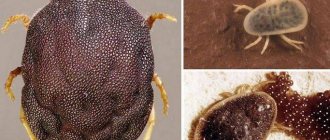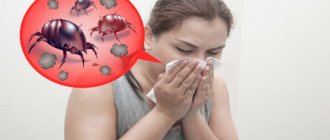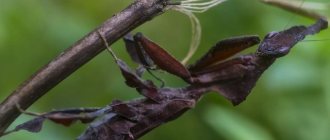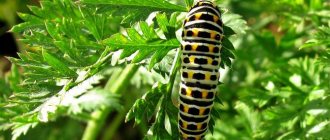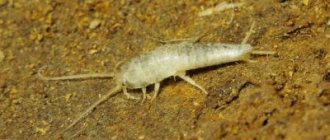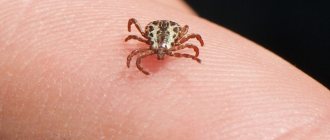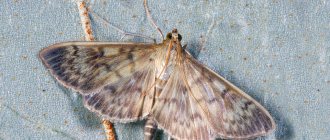Characteristics of ticks
Ticks differ in size, lifestyle and damage they cause.
However, among the representatives of the subclass of ticks there is not a single species that is capable of moving quickly. Typically, ticks travel no more than 30-50 meters in their entire life. They move with the help of 4 pairs of legs equipped with special suction cups and hooks that help them stay on the victim’s body. The size of the mites ranges from 0.2 to 13 mm. Males are much smaller than females. Some types of ticks are permanent residents of the skin and hair of warm-blooded animals. Their pathological reproduction is most often a consequence of malfunctions of the immune system. Sculpture of Aristotle
Aristotle was the first to study methods of exterminating ticks. When deciding how to deal with ticks in a dog, in his “History of Animals” he proposed treating them with the use of elemental sulfur. Another mention of ticks dates back to 610 BC. It belongs to the Chinese scientist Chao Yuan-Fan, who first suggested that tick infestation is the cause of a number of diseases.
The most common types of ticks:
- Dust and bed mites. They are saprophytes, that is, creatures that feed on dead organic matter and do not need a host organism. They live in dusty areas with high temperature and humidity. Despite the fact that the insects themselves are not aggressive towards humans or animals, they can cause the development of dust (mite) allergies. Rather than guessing how to get rid of mites living in dust, it is better to take preventive measures against their occurrence. The most effective methods are wet cleaning, timely removal of dust, freezing of carpets, upholstery of chairs, mattresses and blankets. The need to poison ticks in apartments and own houses is extremely rare.
- Predatory mites. They differ in that they lead a predatory lifestyle and hunt their bed and dust brethren. Thus, controlling ticks in an apartment is the main activity for these species. All types of predatory ticks do not cause any harm to humans.
- Ixodid ticks. Among ticks whose attacks on humans are dangerous for humans and domestic animals, a record number of species belong to the family of ixodid ticks. There are more than 240 species in the genus. Another name is hard mites. Among the most dangerous are taiga and canine ones. Despite the name, these species are so widespread that recently owners have increasingly had to decide how to remove a tick from a cat.
- Subcutaneous mites. There are scabies and ear infections. They cause an itchy rash and are transmitted through contact with infected warm-blooded animals. Earworms extremely rarely parasitize people, choosing cats, rabbits or dogs for themselves.
- Barn mites. Capable of causing serious damage to grain stocks. They have a long multi-stage development cycle and a pronounced allergic effect on warm-blooded animals.
- Spider mite. A malicious pest of greenhouse and indoor plants, a characteristic sign of which is the sudden drying of the affected plants and the appearance of cobwebs on them on the inside of the leaves.
- Strawberry mite. Has a length of 0.2 mm. Males are one and a half times smaller than females. Over the summer, up to 7 generations can change. Grows quickly in warm and humid climates. Carries dangerous viruses.
Dust and predatory mites
In apartments, mites live in thick dust and feed on water-salt compounds that remain in it as a result of human activity. These representatives of arachnids do not parasitize warm-blooded creatures, but can cause them no less trouble than their saprophagous brothers. The excrement of little neighbors contains substances that cause allergies in humans. The disease can manifest itself in the most unexpected ways, for example:
- Rashes on the body;
- Attacks of suffocation;
- Allergic dermatitis.
These small insects cannot be seen without a microscope, since their size does not exceed 0.23 mm. They can place their nests either behind the sofa in a fair layer of dust or in bed. Microscopic parasites can be brought into the house after visiting a hairdresser, traveling on a train, or a laundry; they travel in feather beds and pillows, so doctors recommend not using feather bedding.
Along with small arthropods, the dust is inhabited by their larger fellow predators who eat them.
Dust mites in the house: what to do? First of all, create unfavorable conditions for their reproduction. Optimal conditions for the life of arthropods are relative humidity within 70% and air temperature 25°C. Reducing the humidity level to 40% and regularly cleaning dust in the premises will reduce the pest population. It is very important to wash bed linen in hot water and be sure to iron it without steam to prevent the fabric from picking up moisture. A rational solution would be to get rid of pillows, feather beds and blankets made from bird down or feathers.
Danger from ticks
The arachnid insect (mite) is dangerous for both humans and plants. The damage caused by the bloodsucker is as follows:
- The tick is an active carrier of such dangerous diseases as tularemia, fever, encephalitis, tick-borne typhus, and Lyme disease. In such conditions, the human central nervous system is seriously affected. But only 7 types of ticks act as carriers of infections. All others only provoke unpleasant itching when they come into contact with the body.
- Spider mites carry gray and root rot, which destroy plants. Including indoor ones.
Spider mite
- Some varieties of mites are capable of completely killing fruit crops on the site, such as walnuts, plums, apple trees, pears, linden trees, and grapes. Settling under fruits, flowers or foliage, the insect simply sucks nutrients from the plant over time. As a result, the tree finally dies.
To prevent such troubles from happening, it is advisable to get rid of ticks in your summer cottage forever.
Tip: inspection of the territory for the presence of bloodsuckers is carried out using a wooden meter stick and a piece of white waffle fabric. It is tied to a pole like a flag and slowly dragged along the grass after the dew has disappeared. If there is a tick in the area, it will easily get caught on the fabric and will be visible on the white base. Collecting ticks from the lawn
Diseases
The most common diseases carried by ticks are borreliosis, ehrlichiosis and encephalitis. Infections are severe and can cause disability. As a rule, the diseases are chronic in nature and have a long rehabilitation period of up to a year. In addition to the diseases listed above, ticks carry:
- spotted fever;
- tularemia;
- babesiosis;
- tick-borne typhus
The variety of linen mites is not a blood-sucking pest, but these insects are also dangerous to humans. Microscopic excrement of insects along with dust penetrates the lungs and provokes the development of allergic reactions. In combination with a cold, allergies can cause bronchial asthma.
Allergy symptoms
The manifestation of disease symptoms depends on the pathogen that enters the human body after an insect bite. Since pests carry a large number of diseases, each of them is characterized by individual symptoms. In particular:
- Borreliosis is characterized by the appearance of migraines, general fatigue of the body, fever, attacks of nausea and vomiting. The most pronounced sign of the disease is a rash on the skin in the form of a ring-shaped redness.
- Tick-borne encephalitis causes a sharp increase in temperature to 39 degrees. Other symptoms include muscle soreness, vomiting and migraines.
- Ehrlichiosis is characterized by a sudden increase in body temperature and chills, joint pain, and a feeling of malaise. In severe cases, a skin rash appears.
- Symptoms of tick-borne relapsing fever develop gradually over a couple of weeks. Primary signs are insomnia, lack of appetite and feeling weak. Subsequently, the temperature rises, pain in muscles and joints occurs, and a severe rash forms on the skin.
How dangerous are dust mites for humans?
Compared to the forest mite, which bites a person painfully and can provoke various diseases, the dust mite does not have such serious consequences due to its very small size. And yet, its harm to humans can be quite significant, under certain conditions.
For example, one gram of dust can contain up to 100 individuals. When their numbers increase to approximately 500 individuals, the body's reaction to their waste products is felt. If the number of parasites increases to 1000, this can lead to the development of bronchial asthma, as well as a persistent allergic reaction.
As a result of dust mite activity, the following are possible:
- Cough.
- For irritation of the skin and mucous membranes.
- Tearing.
- Sneezing.
- Chronic runny nose.
- Allergic reactions.
- Throat problems.
- Conjunctivitis.
Types of house ticks
Several species can simultaneously live in a person’s apartment, each of which has its own location. Some species can be blood-sucking, others feed on dead cells, and still others parasitize houseplants and animals. But there are also more dangerous representatives of this class, which do not just attack a person, but settle on the body, under the skin or in the ears.
Dusty
Dust mites are the most common neighbors of humans and can be found in almost every apartment. This species cannot be noticed by the human eye, but if the parasite population exceeds acceptable standards, this can have an extremely negative impact on health, especially for young children. These mites feel most comfortable at a humidity of 50% and a temperature of 18 to 25 degrees, which is most often room temperature.
The favorite locations of dust mites are books, soft toys, sofas, bedding, carpets and absolutely any surface on which a large amount of dust accumulates.
Such parasites feed on dead skin cells and do not have direct contact with the human body, which does not make them any less dangerous. The greatest threat is posed by the waste products of the parasite, which accumulate in a person’s home every day. They are one of the most powerful allergens and easily penetrate the respiratory tract. The consequence of a large accumulation of dust mites is allergic rhinitis, asthma, dermatitis, conjunctivitis and even angioedema.
Ixodes
Ticks of this species are one of the largest representatives of the class and are found on absolutely any continent and in any climatic zone. Such parasites are not permanent residents of apartments or houses, but very often get there with the help of pets or on clothing. Parasites are blood-sucking and easily find a future victim. Ixodid ticks are most active from May to September; when returning from a walk during these months, it is necessary to carefully inspect the clothing and fur of your pet. The most terrible consequences are considered to be encephalitis, borrelosis and Lyme disease. If an ixodid tick bite is detected, you should not only remove the parasite, but also take it for analysis to the nearest laboratory.
Arachnoid
If a spider mite has settled in an apartment, the first place to look for it is a windowsill with house plants. This parasite, contrary to the erroneous belief, is not an insect, but an animal and is constantly in search of food. It may appear with a new purchased plant or sneak through an open window. This species attacks the plant quite quickly and easily moves onto healthy flowers. It does not pose any direct harm to humans, but may not destroy all home greens.
Dust mite: description
This is a parasite that is difficult to notice with the naked eye, since its length does not exceed 0.5 mm. As for the human home, it is an ideal habitat for this type of pest. They actively reproduce in conditions where they feel comfortable. In a couple of months, females lay several dozen eggs, which indicates their enviable reproduction rate. Due to their fairly small size, parasites manage to remain unnoticed in a person’s home for a long period. They are not so annoying compared to other types of parasites, so they always remain in the shadows, feeding on dead particles of human skin and the woolen fluff of various things.
Ticks prefer:
- Warm places.
- Moderate humidity.
- Places where there is a lot of dust.
The main habitats are:
- Feather pillows.
- Wool blankets.
- Floor coverings.
- Carpets of natural origin.
- Kids toys.
- Cabinets where rags and rubbish have accumulated.
- Sleeping mattresses.
- Hard to reach places.
Dust mites and dust allergies
Biological drugs
If there are children on the site, aggressive chemicals are contraindicated. Here you can get by with no less effective, but at the same time relatively safe biological drugs. These have proven themselves well:
- Apollo;
- Fitoverm;
- Aktofit;
- Vermitek.
Unlike chemicals, biological compounds can be used during the flowering or fruiting period of plants. Most drugs are resistant to rain. But here the tick does not die immediately after treatment, but within 3-5 days.
Reasons for appearance
Even in a completely new and clean apartment, ticks can appear. Let's consider the main reasons for this phenomenon. Neighbours. Ticks, unlike other insects, such as bedbugs, do not migrate from apartment to apartment. However, neighbors can also bring it on their clothes or with some things. New things, technology. Furniture and equipment, before appearing in your apartment, were in stores or warehouses, where in any case there is dust, and this means there may well be mites. Pets. As a rule, dogs walk outside and can bring mites along with dust on their fur.
Danger to humans
There are several types of ticks living in nature. The most dangerous mites are those that parasitize human skin. These are the so-called ixodid ticks.
Parasites are not picky when choosing a food source. They feed on the blood of forest animals and some species of birds. The virus of tick-borne encephalitis, a dangerous disease, develops in the tissues of animals without causing them harm. Humans have no immunity to this infection. In addition to encephalitis, ticks carry borreliosis, typhus, tularemia, etc. You should beware of a tick bite infected with a dangerous pathogen. Infection occurs when the bloodsucker pierces the skin. Microorganisms are contained in the parasite's saliva, which enters the blood.
Habitats
To avoid potential danger, you need to know that the tick prefers small forests, where the rays of the sun rarely shine. Most often, ticks wait for victims in the following places:
- In clearings next to the undergrowth;
- In ravines and bushes;
- In lake thickets;
- In the bushes next to the trails.
A common false claim is that ticks live on trees. This is far from true. Parasites wait for the victim, hiding in the grass and on the branches of bushes. A potential threat could be a dacha plot located near a forest area. On warm days, a tick can wait for a gardener in the weeds near the site.
How to prevent the appearance of dust mites in an apartment
The list of basic rules includes:
- Clean the rooms regularly using a vacuum cleaner. At the same time, you should not forget to vacuum upholstered furniture, carpets and floor coverings.
- Clean the vacuum cleaner filter regularly.
- Avoid decorative items that actively collect dust.
- Do not accumulate old, unnecessary things and household items.
- Wash and iron bed linen regularly.
- Choose furniture with upholstery that has dust-repellent characteristics.
- Control the humidity level in the room.
- Wash floors only with disinfectants. The simplest option is to use salt, 3 tbsp. spoons per 10 liters of water. After this, you need to wash off the salt with clean water.
- Do not install multi-layer curtains made from fabrics that collect dust in your home.
- After sleep, do not rush to make your bed, as fresh air and light have a detrimental effect on dust mites.
- Make sure that soft toys are washed and free of dust.
- Always ensure that books, lampshades, tapestries, embroidered paintings, etc. are not covered with a layer of dust.
- Regularly check that the apartment is ventilated. Outdoor air has a detrimental effect on dust mites.
The more dust (dirt) in a person’s home, the greater the concentration of dust mites, which negatively affects human health. Despite the fact that their influence is indirect and there is no direct threat from them, it’s time to think about cleanliness in your apartment or house. The most interesting thing is that fighting dust mites is quite simple, without resorting to any extreme actions. In this case, it is enough to ensure that there is no dust in the home. There is dust, which means there are mites, and if there is no dust, then there are no mites. In any case, you will have to reconsider the approaches to organizing regular and high-quality cleaning of your home every day.
What ticks are potentially dangerous to humans?
Not all ticks are parasites. Some of them are completely harmless and even beneficial. For example, saprophagous mites, feeding on the remains of plants and animals, heal the ecosystem.
The following superorders of ticks are distinguished, differing in their feeding behavior:
- Parasitiforms;
- Acariformes;
- Haymaking mites.
Among ticks, the greatest danger to humans is the so-called parasitiform ticks. Representatives of the parasitiform superorder are gamasid and ixodid ticks. Both of them feed on the blood of humans and domestic animals.
The order Acariform mites is divided into two groups. These are sarcoptiform and thrombidiform parasites. The first group includes the well-known dust mites, hair mites and scabies mites. Spider mites, which parasitize cultivated plants, represent the second group.
Types of ticks in the house
Several species of these dangerous arachnids can exist in the vicinity of humans. Moreover, some of them not only live nearby, but also prefer to feed on the blood of people and pets. And the waste products of others cause the development of allergies.
Dusty
This mite is most often found in apartments. The insect is small in size from 0.1 to 0.5 mm, so it is impossible to see it with the naked eye. The mite feeds on dust, which is why it got its name. The insect is widespread on all continents. 1 g of dust can contain up to 150 species of dust mites.
Dusty
The life cycle of the insect is 65-80 days. Dust mites can live and reproduce in an apartment all year round. Optimal conditions: temperature within +18…+250С and high humidity.
A female dust mite makes hundreds of clutches throughout her life, each containing 60 eggs. The waste products of this species are one of the causes of the development of bronchial asthma.
Ixodes
This type of tick is considered one of the largest, its body size reaches 2.5-4.5 mm. The color of the insect is brownish-brown. Ixodid ticks are found on all continents except Antarctica and are able to live in any climate zone. This species belongs to the blood-sucking category. Insects live on the street, in parks, gardens, forests, hiding in thickets of grass and bushes, waiting for their prey. They prefer warm, humid places.
Ixodid ticks are especially active in spring and late summer. But some individuals cannot sleep even in winter. Forest ticks enter apartments on the fur of pets, people’s clothing, in baskets with mushrooms, and also with bouquets of wild flowers.
How long a forest tick lives in an apartment depends on the availability of favorable conditions. For full life, it needs soil and moisture. Therefore, it cannot exist in a human home for a long time, but even its short-term stay in the house threatens residents with serious health consequences.
Ixodes
Bed
This type of arachnid insect belongs to the category of synanthropes. The bed mite has a microscopic size, its body length reaches no more than 0.5 mm, so it is impossible to detect it without a special device. It feeds on dead skin particles and dandruff. It is impossible to suffer from the bites of these parasites, since they do not feed on human blood. But this does not make them any less dangerous than their counterparts.
The lifespan of such insects is 65-80 days, but without food in the apartment, the tick is capable of falling into suspended animation and remaining there for four years until favorable conditions appear. The female lays from 3 to 8 thousand eggs throughout her life.
Bed
How to remove a tick
If a person is bitten by a tick, it should be removed quickly, because The longer he is in contact with a person, the higher the risk of contracting dangerous infectious pathologies. It is necessary to remove the parasite from any place on the body, strictly following the technique to prevent the body from being torn off from the head. The parasite must be twisted out and not torn off, since it is deeply and tightly sucked to the skin with the help of a proboscis with processes that hold it.
You can remove a tick at home with your hands, using a thread, tweezers, a syringe or special devices (Tick Twister, Anti-Tick, Nippes), which are available in pharmacies. Such tools resemble a hook or tweezers, but have a special modified shape to make it easier to remove the parasite. It is recommended to take these devices with you when going outdoors.
- What determines the size of the old-age pension - calculation procedure
- Border Collie - description and breed standard, characteristics and color, training, keeping at home
- Corvalol tablets
Tweezers
One of the most popular tick removal tools, Nippes, helps to grab the insect as tightly as possible and close to the skin, which prevents it from tearing. This is an important advantage, since the remaining part of the skin is a source of pathogens that the parasite carries. The disadvantage of using tweezers is the risk of skin damage if used incorrectly.
Nippes should be used as follows: grab the arthropod between the teeth of the tool, turn it counterclockwise, slightly pulling it towards you. After removing the parasite, treat the suction area with iodine or alcohol. For using regular tweezers, there are the following recommendations:
- Using tweezers, grab the insect's head at the very base, remove it with rotational movements, the parasite should twist out without effort.
- It is better to place the instrument parallel to the skin.
- After removal, lubricate the skin with an antiseptic.
Hands
The disadvantage of removing the parasite by hand is the high probability of crushing the insect and tearing its body, which can provoke infection with encephalitis, so this method is considered the most undesirable. The advantage of removing an insect by hand is that there is no need to use special or improvised tools. You should remove the parasite with your fingers like this:
- Treat your hands and skin around the bite with an antiseptic.
- It is recommended to wear disposable gloves or wrap your hands with gauze or a bandage.
- Grasp the tick at the junction of the body and the head as close to the skin as possible.
- Using a few counterclockwise rotations, slowly remove the insect.
- Treat the affected area with an antiseptic; it is recommended to place the insect in a plastic container and submit it to a laboratory for examination. After the procedure, you should wash your hands with soap.
Thread
One of the easiest methods for removing a tick at home is to extract it with a thread. Among the advantages are its availability and speed. A significant disadvantage of thread removal is the high risk of incomplete extraction of the parasite. The sequence of actions during the procedure is as follows:
- Lightly press your fingers onto the skin near the attached insect.
- Take a thread (preferably synthetic, because it is stronger) 20-30 cm long, make a small loop in the middle.
- Place the middle of the loop on the skin so that the parasite gets into it.
- Tighten the loop tightly into a knot, connect both ends of the thread into one and twist it counterclockwise with your fingers.
- Once the thread is tightly twisted, pull it towards you.
- Treat the skin with iodine or alcohol.
- Siberian fir
- Including the period of child care in the pension period
- 7 Best Exercises for Older People
Using oil
Removing ticks from a person using oil involves cutting off the access of oxygen to the insect, which forces it to detach itself. The advantage of the method is that there is no risk of damage to the bite site or the body of the parasite, but the disadvantage is that it is often ineffective. Experts believe that due to the lack of oxygen, the insect begins to inject large amounts of saliva, which may contain infection, increasing the risk of infection. Removing a tick using oil should be done as follows:
- Fill the bite area with sunflower oil or any other vegetable oil. Sometimes it is acceptable to use a rich cream.
- Once the tick detaches from the skin, destroy it.
- Treat the wound with alcohol or antiseptic.
Syringe removal
The parasite can be removed using a disposable syringe without a needle. The advantage of this method is its simplicity, but the disadvantage is the high probability of tearing off the head of the tick and its incomplete removal from the skin. Removing the parasite using a syringe should be done as follows:
- Treat the area around the attached insect with alcohol, cologne or antiseptic.
- Remove the syringe from its packaging and slide its plunger down.
- Press the syringe to the surface of the skin so that the parasite is completely hidden in the “nose”.
- Slowly pull the plunger up.
- After the insect separates from the skin, wipe the wound with an antiseptic again.
Appearance, habitat
A microscopic creature with body sizes from 0.1 - 0.5 mm. The features of his body can only be seen using a magnifying glass. About 150 species of dust mites can live in the home. All of them are synanthropic, live in apartments, houses, feed on skin scales, animal fur, and bird feathers.
The lifespan of an adult is 80 days. During this time, she manages to lay 60 eggs. Favorable habitat is humidity from 55%, temperature from 22 degrees Celsius. Ticks in the house are localized in places where food is available. Most often this is:
- carpets;
- paths;
- curtains;
- blankets;
- pillows;
- bedspreads;
- upholstered furniture;
- mattresses;
- Stuffed Toys.
And also places where cleaning has not been carried out for a long time - bookshelves, cabinets, floors, baseboards. House mites do not like the bathtub, toilet, because there is high humidity, balconies, or window areas where there is a draft.
Important!
Mites live in an apartment or house in numerous colonies - up to 10 thousand per 1 g of dust. The standard concentration for regular indoor cleaning is 100 pieces per 1 g of dust. This concentration is safe for humans and does not cause deterioration in well-being. Exceeding this indicator leads to allergies even in those who have not previously suffered from it.
Folk methods of struggle
If you want to do without chemicals completely, then it is better to use proven folk remedies. Experienced summer residents recommend the following:
- Irrigation of the area with solutions of essential oils. In particular, rosemary and mint. It turns out that the tick does not tolerate these odors. It is enough to add 5-10 drops of oil to water and spray it on garden crops.
- Citrus juice. It also works well as a bloodsucker remedy. Moreover, you can use both fresh juice and aromatic oils of orange, tangerine, and lemon for irrigation.
- Boric acid or soda. These products need to be sprinkled in places where ticks accumulate to get rid of them.
- Infusion of wormwood. Here you need to take 2 kg of chopped grass and pour moderately hot water (10 liters) for two days. After this, the infusion is boiled for half an hour. All that remains is to bring the decoction again with cold water to a volume of 10 liters. The finished product is diluted with clean water in a ratio of 1: 2 and the area is sprayed. Using the same principle, you can prepare infusions of geranium or sage. They also repel ticks.
- Garlic infusion. To prepare it, add two liters of water to four heads of garlic. Infuse the solution for 5 days in a dark and cool place. Before irrigating the area, the product is diluted with water in a 1:1 ratio.
- Cyclamen roots. An infusion is prepared from them according to this recipe - 100 grams of tubers are poured into 1 liter of boiling water. Now cook the roots until they are completely cooked until they soften. The finished product is cooled and strained. The area is sprayed with the decoction.
- You can also plant natural insecticides around the perimeter. These are chamomile, wild rosemary, tansy, bird cherry. They repel the bloodsucker and prevent it from entering the area.
Advice: in order to protect the territory as much as possible from tick invasion, it is advisable to team up with your neighbors and carry out simultaneous treatment of two or more areas. It is advisable to take the family to the dacha no earlier than 4-6 days after baiting the insect.
Methods of control and prevention
If there is an infestation of ticks, you must immediately take measures to combat the parasites. To reduce the likelihood of pests reappearing, preventive measures must be taken.
Low temperature and humidity
Ticks live comfortably at high temperatures and excess air humidity. To combat the invasion of parasites, it is necessary to create a low temperature and reduce the humidity level. In the cold season, to eliminate insects, you can ventilate, and leave mattresses and bed linen on the balcony or outside and thoroughly beat them before returning them to their place. Also, dust mites die from washing bed linen at a temperature of 60 degrees.
Wet cleaning of the apartment
Regular wet cleaning and dusting eliminate the majority of insects and reduce the risk of their reproduction and spread. It is recommended to wipe the floor and baseboards with a salt solution, which has a more powerful effect against insects. A solution for wet cleaning against insects is prepared using the proportions of 5-7 tablespoons of salt per bucket of warm water.
Washing bed linen and upholstered furniture at high temperatures
Washing bed linen in a machine at high temperature destroys accumulated parasites. After washing, bedding should, if possible, be thoroughly dried in the open air or on a balcony with open windows. To combat insects, the upholstery of upholstered furniture can be periodically wiped with a cloth soaked in warm water or a specialized detergent.
Freezing
Exposure to extremely low temperatures is detrimental to insects, so parasites can be removed from small items, fabrics and clothing by freezing. It is enough to leave things in the freezer for several hours to destroy all ticks and other insects.
Special bedding
It is recommended to replace feather and down bedding with synthetic ones, since they are less likely to harbor parasites. The same should be done with upholstered furniture, including chairs and sofas made of down and feathers, which serve as a habitat for parasites.
Minimum indoor plants
Dust mites love to settle on house plants and leave larvae on them. Parasites live in the soil and on the surface of the green parts of plants. Since processing plants takes a lot of time and does not guarantee complete destruction of insects, it is recommended to keep no more than a couple of pots in the room. This will reduce the number of pests
Essential oils
There are several essential oils whose scent is repellent to ticks and other parasites. Common pest control options include geranium and palmarosa oils. To prepare a remedy against ticks, you need:
- Mix 2 tablespoons of vegetable carrier oil and 10-25 drops of essential oil.
- To protect against parasites, apply a few drops of the resulting solution to clothing and skin, avoiding areas around the eyes.
A mixture of essential and base oils to combat parasites can be stored for six months. After this period, the substance gradually loses its protective characteristics and has a worse effect on pests.
Vacuum cleaner
According to the principle of operation, a vacuum vacuum cleaner differs from the standard version. The equipment helps remove dust mites and insects from any soft surfaces, including furniture upholstery, carpets, curtains, bedding and toys. Immediately after surface treatment, it is quite difficult to notice the result and the absence of pests, so to assess the effectiveness it is worth looking into the filter where dust accumulates.
It is recommended to clean with a vacuum cleaner on a regular basis, combined with wet dusting, which will help to better get rid of parasites.
Methods of disposal
It is extremely difficult to get rid of ticks in an apartment due to the wide variety; each individual species requires additional means of extermination and it is not always possible to eliminate unpleasant neighbors the first time. First, you need to decide what type of ticks you have to fight, and then start choosing household chemicals or give preference to folk remedies.
Folk remedies
To effectively get rid of annoying parasites, not only expensive and specialized products can help, but also some improvised products and substances that can be found in almost any apartment. The main difficulty in removing ticks at home is their small size and large area to be treated. But with the help of traditional methods, the risk of poisoning is reduced, especially in the case of apartments where there are small children.
Dust mites . These parasites have to be gotten rid of most often, and the places where they spread occupy almost the entire area of human habitation.
,To prevent and get rid of such a neighborhood, it is recommended to use the following means:
- Salt and soda. It is necessary to add these products when washing floors or wiping dust; just 1 tablespoon of each product is enough for 10 liters of water. Do not increase the amount of the substance to avoid the appearance of a white coating on the floor and furniture. It is recommended to use this method at least once a week.
- Essential oils. Ticks have an extremely negative attitude toward most essential oils with strong, rich odors: lavender, rosemary, eucalyptus, geranium, orange, grapefruit, and so on. For 10 liters of water you need an absolutely large amount, no more than 5 drops.
- Natural flowers. By analogy with essential oils, dust mites are repelled by many indoor plants or fresh flowers. It is recommended to grow geraniums and place small bouquets or sachets of mint, lavender or chamomile in the most vulnerable places. This product has its effect only during the period when it is capable of emitting an odor; if necessary, the sachet should be changed.
When fighting dust mites, these folk remedies are the most effective, but they will not save the entire situation without regular cleaning of the apartment, changing of linen, constant dusting and humidification of the room.
IMPORTANT:
When fighting ticks, cleaning alone is usually not enough; it is also necessary to thoroughly treat the furniture, wash clothes and bedding, followed by ironing at high temperatures or steaming.
Ixodid ticks . An encounter with such a parasite not only cannot be called pleasant, but also far from safe. However, in this case, it is recommended not only to use protection methods, but also to follow simple rules: do not go into the forest and main habitats during the period of parasite activity, use clothing that protects the body as much as possible.
ON A NOTE:
To get rid of ticks, there are a number of specialized products, but you should carefully study the instructions for use; a large percentage of purchased formulations cannot be used in rooms where there are people, much less children and pets.
- Peppermint spray. It is very simple to prepare this repellent; you need to add three teaspoons of a small percentage of vinegar to 25 drops of mint essential oil and finally combine with three teaspoons of water. For ease of use, it is recommended to place the resulting product in a small bottle with a spray bottle and use it before walking.
- Carnation. It is not the plant itself that has a deterrent effect, but its inflorescence, which is a spice. A tablespoon of cloves is added to a small container with 250-300 ml of water, the liquid is brought to a boil and infused for 10 hours. The resulting solution can be used to protect the body from tick bites, and can also be used to treat the main cracks and furniture in the apartment.
Spider mite . This species is small, barely noticeable in size, but is capable of destroying not only home flowers, but also the entire crop of people living in their home. The most gentle methods for plants will be traditional methods, which can be used for any type of flower.
- Laundry soap. A solution of this substance gets rid of most known microbes and parasites, and also perfectly protects against spider mites. 200 grams of pre-grated soap are dissolved in a bucket of warm or hot water. It is recommended to leave the resulting solution for several hours and only then treat the affected plants. The leaves are treated with a sponge; you also need to wipe the pot with it and spray the ground. Soap foam should be washed off with cool water after 3-4 hours.
- Ammonia. Treatment with an alcohol solution is also a highly effective way to combat emerging pests. To prepare the solution, combine a bucket of water and 30 ml of alcohol, then treat the leaves and stems with the resulting solution. It is worth acting as quickly as possible, especially on plants with thin leaves.
- Rosemary. To effectively get rid of spider mites, you should dissolve a few drops of rosemary essential oil in a liter of water and wipe the infected areas with the resulting solution.
Physical and mechanical methods
Direct action on ticks is the most effective, and most importantly safe for humans. To get rid of ticks, you need to create unfavorable temperature conditions or significantly change the humidity in the room; there are several ways to get rid of several types of ticks yourself at once:
Steam cleaner. This method is one of the simplest to implement and can cope not only with existing ticks, but also serve as an excellent preventive measure. Regular cleaning and frequent changes of bedding will minimize the reappearance of mites in high concentrations.
Ventilation. This method of fighting ticks is especially relevant in the cold season, which is the least comfortable for the main life processes of ticks. A comfortable temperature for all the most important life processes of a tick is a delta of 18 to 25 degrees. By lowering or raising the temperature, not the most comfortable conditions for the existence of ticks are created, thereby allowing the pest to be eliminated quickly and almost forever. It is also recommended to wash bedding at high temperatures and dry it in frosty air in winter and in direct sunlight in summer.
INFORMATION:
All actions to get rid of ticks must be done from top to bottom; first, baseboards and corners under the ceiling, cornices and chandeliers are treated. Next, wipe the hard surfaces of furniture and doors. Then start processing the batteries and washing the floor. After cleaning, be sure to ventilate the room.
Reasons for the appearance of ticks in a summer cottage
The following can be distinguished:
- Food shortage, stimulating the search for new places. In a day they can cover distances of 10 m to find food.
- Placing a summer cottage near a forest.
- The appearance of parasites among neighbors.
- Bringing them in with the help of pets.
- When purchasing a plot, there is a risk of ticks. If they appear after 18-24 months, they were present initially, since their eggs mature during this time.
Destruction of ticks on the site
Pyrethroids are an excellent means for killing ticks on the site - this remedy has proven itself among many summer residents. If you decide to fight insects on your site, then feel free to use synthetic or natural pyrethroids. They are safe for humans and dogs. In addition, pyrethroids do not tend to accumulate in the ground, poisoning all surrounding plants.
Of course, chemical pyrethroids have some disadvantages:
- Kill insects (for example, bees);
- Toxic to fish;
- Toxins for cats.
It is justified to use pyrethroids if you want to treat a playground, garden or paths. However, their use on large areas is not recommended. The destruction of ticks in the country should be consistent and systematic. It is better to treat small areas little by little rather than irrigate all surfaces of the site at once. As for pyrethroids, they are also available in natural form.
Pyrethrin is a natural insecticide that is found in some daisies, which are often planted in certain flower beds. For example, use Caucasian chamomile and Persian chamomile. Dalmatian chamomile can also be used as a tick repellent. These flowers can serve both as decoration for your flower beds and as guards for your plots. Naturally, the pyrethrin contained in chamomile is not as rich as the synthetic one, but it is still quite active.
Prevention of ticks in the country
Destruction of ticks is the second thing. And first, before the tick epidemic began and they began to sit on every bush, at least minimal preventive measures should be taken. Remember that ticks are most likely to appear in cluttered areas. Therefore, remove all fallen leaves, remnants of vegetation, and also, do not be lazy to frequently mow your country lawns. One of the main breeding grounds for ticks is mice - they are a source of insect larvae. In addition, it is from mice that ticks receive encephalitis infection, which can then be transmitted to people whom ticks bite. Therefore, indirect control of ticks is active control of mice.
Sources
- https://bezbukashek.ru/kleshi/kak-i-chem-borotsya-protiv-kleshhej
- https://nedvigdom.ru/kak-izbavitsya-ot-kleschey/
- https://hozzi.ru/uborka/kak-izbavitsya-ot-kleshhej
- https://kakchistim.ru/vrediteli/kleshchi/kak-samostoyatelno-izbavitsya-ot-samyx-rasprostranennyx-vidov-kleshhej-v-dome.html
- https://www.nasecomih-net.com/2019/02/16/kak-samostoyatelno-izbavitsya-ot-klesha/
- https://diy.obi.ru/articles/borba-s-kleshami-na-dachnom-ychastke-21289/
- https://www.nasecomih-net.com/2019/01/26/sposoby-borby-s-kleshami/
- https://sovets24.ru/1837-5-sposobov-udalit-klecsha-s-tela-cheloveka.html
- https://MrDachnik.com/kak-izbavitsya-ot-kleshei
- https://stoppestinfo.com/ru/449-unichtozhenie-kleshchej-na-dachnom-uchastke.html
[collapse]

